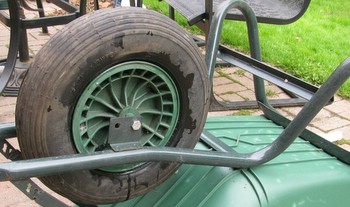We left our wheelbarrow out in a corner of the backyard all winter. In the spring the tire had completely deflated, and as it is a tubeless tire (similar to car tires) it had come off the rim as well. Simply sticking an airpump on the valve did nothing as the tire no longer touched the rim in a number of places letting all of the air out.
One solution  would have been to simply buy a new tire. I thought that being like a car tire, I could probably take it by a local garage and have them do it for me. However, I had a nagging feeling there was some way to DIY so I finally got to searching for a solution.
would have been to simply buy a new tire. I thought that being like a car tire, I could probably take it by a local garage and have them do it for me. However, I had a nagging feeling there was some way to DIY so I finally got to searching for a solution.
It was very easy to find some good advice on the net (this is as you know, not always true). So the value of this post is probably limited, but I learned something today so I thought I’d share.
Tools you need: rope, air pump, long screwdriver or sturdy stick, soapy water.
- Use the soapy water (1/2 water, 1/2 dish soap) to coat the beads of the tire (both sides) and the rim where it will mate up.
- Tie the rope snugly around the circumference of the tire.
- Stick the screwdriver through the rope and twist, causing the rope to tighten. This should help you get the bead onto the rim on both sides [in my case, it was not quite there – but close enough to seal the gaps]
- Pump the tire. This should cause the bead to set onto the rim. Slowly release the twist while you pump.
That’s it – easy to fix with stuff you should be able to find around the workshop.

